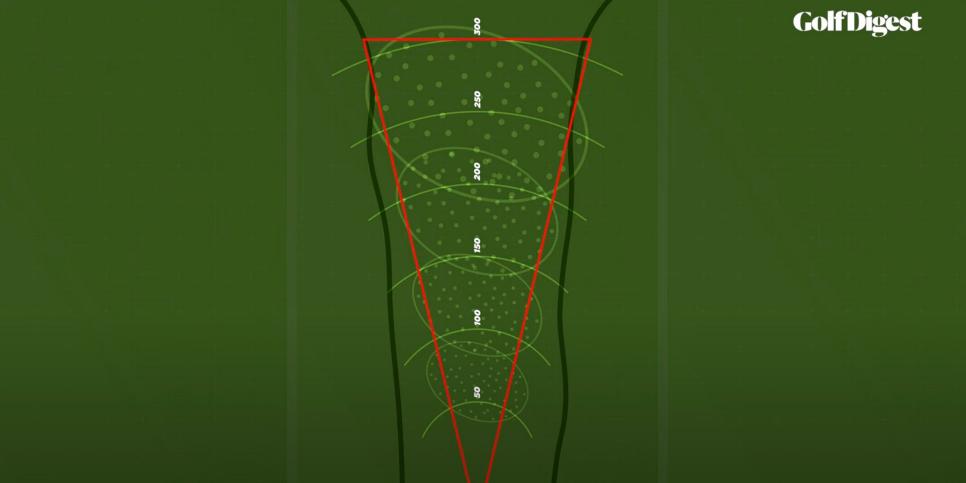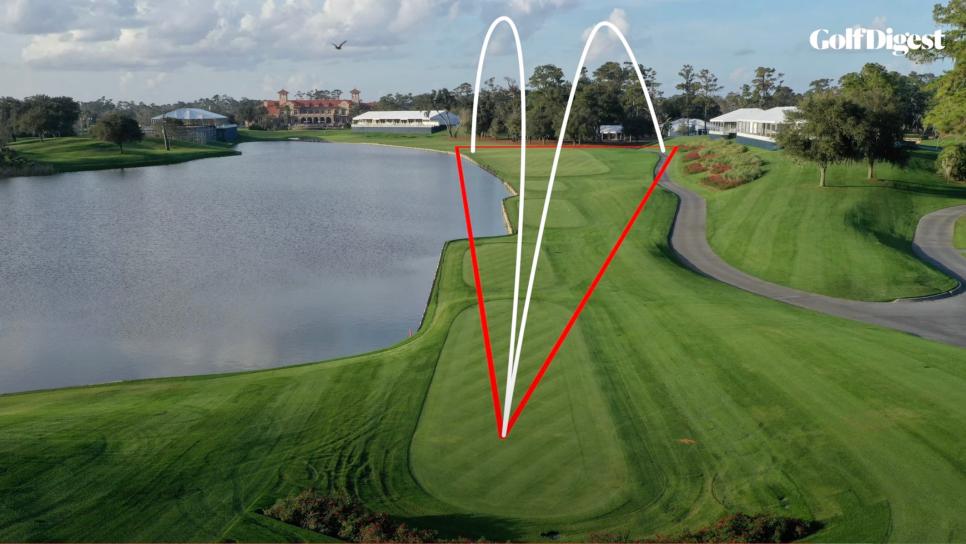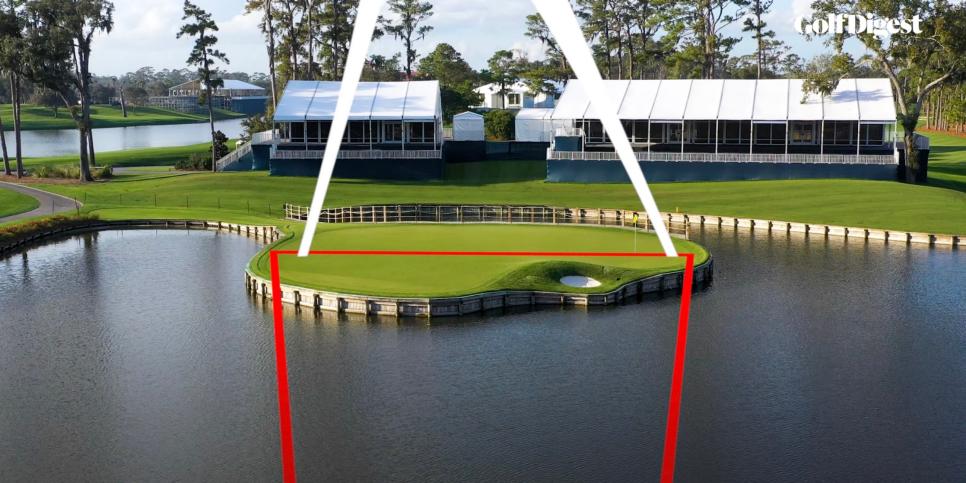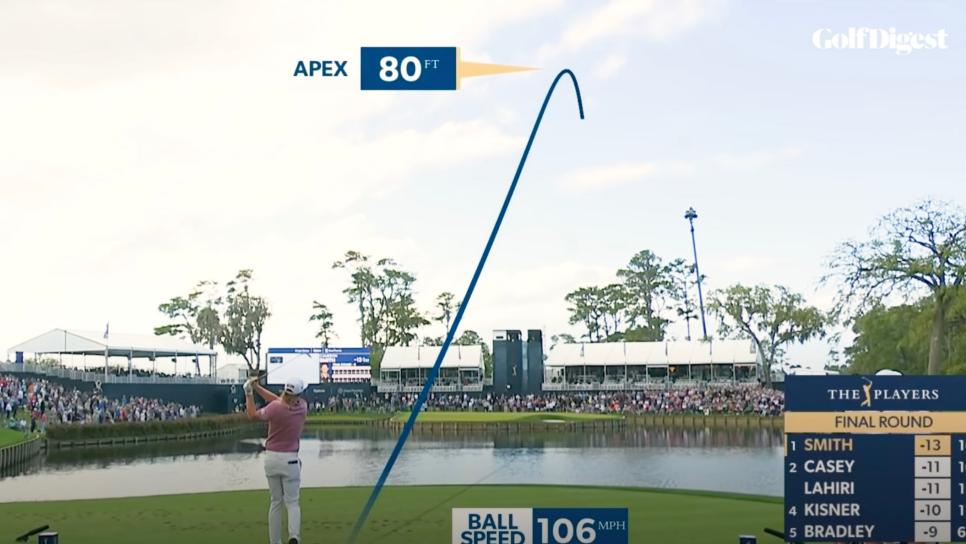Ben Hogan’s most famous quote is that “golf is a game of misses. He who misses the best, wins.”
A simple phrase, but one that has spawned an entire new aiming strategy that pros use on every shot they hit. You’ll see it this week at the Players Championship.
To learn more, you can watch the full video here:
To understand how this works in practice, imagine you stand on that same spot in an open field and you hit 100 shots with each club in your bag. You hit a few perfect ones with each club. But most of your shots go left or right. You stripe some, but others you hit off the toe or heel, so those go a little shorter.
You go from your wedges to your driver. Put them all together and it will form a kind of cone. This cone represents golfers’ total range of left and right misses at each distance.

For tour pros, the top of the cone at about 300 yards will span 70 yards wide, meaning that if the average pro hits a hundred 300-yard drives, most of their drives shots will miss either 35 yards left or right of their intended target.
For amateur golfers, it’s obviously wider. But either way, all these shots together form your cone of misses. This is what you should be thinking about on every shot, on every hole, every time you play.
To see why, think of your cone of misses, and start plugging it onto golf courses.
Like the 18th hole at TPC Sawgrass. It’s not about where your best shot ends up. It’s where all your shots would’ve ended up. One good drive looks fine on paper. But if you were to aim your entire miss cone down the middle of the fairway, like the course’s yardage book suggests, upwards of 30 percent of your drives would end up in the water.
So what do pros do? They aim their miss cone into places that sometimes look pretty weird.
Like on this hole, Scott Fawcett, founder of the DECADE golf-course strategy system, wants players to aim almost directly at the trees on the right, because it shifts the left side of the miss cone into the fairway. It’s weird because, yes, it does mean that occasionally they’ll hammer a near-perfect drive into the trees or cartpath. But by aiming your cone here, you’ve taken your worst 30 percent of misses, the water balls that would cost you about -1.5 Strokes Gained, and moved them in play.

Meanwhile on the other side of your cone, yes, you’ve made your right misses slightly worse. But maybe only a third of a stroke worse (0.3 Strokes Gained). They’re all still in play. Overall you’re coming out way ahead, because you’re leaving your worst misses in a mathematically better spot in exchange for only a slight downgrade on the other side.
This was Justin Thomas’ strategy when he won the Players in 2021. JT aimed right with hopes of hitting a draw, then accidentally hit something close to a snap hook into the left side of the fairway. If he had aimed down the middle, he would’ve lost.
“That’s the kind of stuff that happens when you win tournaments. You get lucky breaks like that.”
This same miss cone concept happens into greens. Fawcett tells golfers all the time to forget about the pin. Remove it from your mind. Aim for the middle of the green, and let the randomness happen.
Another TPC Sawgrass example comes on the famed 17th green.

Let’s say you aimed straight at the Sunday pin on the right of TPC Sawgrass’ 17th. Again, about a third of your miss cone would end in the water. But aim towards the middle, and you’ve turned most of those would-be water balls into birdie putts. Meanwhile your left side misses are still on the green. Sure they maybe a little further away, but from outside 30 feet tour players still two-putt or better more than 90 percent of the time. It’s a trade worth making.
And then sometimes, you’ll get a little lucky. Like Cameron Smith did at the 2022 Players Championship.
With the Sunday pin tucked over to the right of the green, Cameron Smith aimed over the left side of the bunker – a line just right of the middle of the green. And then, just like JT a year before, he hit a shot he didn’t mean to. He even said so afterwards.
Smith blocked his fade slightly too far to the right, but it grabbed the tiniest slice of green on the right side. No golfer hit their ball further right onto that side of the green all day.

Then, Smith made the putt, and ended up winning. His hero shot was actually a miss, which is funny, because if heh had actually tried to hit the hero shot, he would’ve ended up losing.
There are countless examples, but the point is that this is how tour players aim. They don’t think about their perfect shot, they think about all their shots – and especially their misses. That may mean aiming into the rough, or away from pins. It won’t leave your best shots in the best spots, but it will leave your bad shots in better spots. And that’s the entire point. That’s what playing the odds looks like in golf.
And that’s what Hogan figured out himself, before he had any data to validate it. Hogan wrote that “golfers should never, under any circumstances, aim at pin when it was on the corner of a green”, because of where that would leave his misses.
The truth is that the best shots are usually mistakes. And that’s OK. Golf is a game of misses, like Hogan said. And he was right. So plan for them. Play them. And who knows, you may even hit an accidentally perfect shot along the way.



